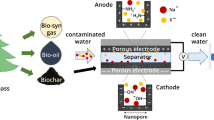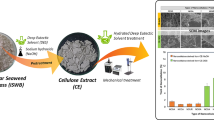Abstract
In this study, we synthesized amine functionalized cellulose nanofiber based adsorbent for effective removal of dissolved fluoride ions from groundwater samples. Cellulose acetate was electrospun into nanofibers followed by deacetylation to yield cellulose nanofibers which were then treated with ethylenediamine to prepare amine functionalized cellulose fabric to be used as an adsorbent. As- synthesized adsorbent was first characterized by scanning electron microscopy and Fourier transform infrared spectroscopy for physiochemical characteristics. Fluoride adsorption studies were then carried out under batch mode to study the influence of various parameters on adsorption process. Amine functionalized cellulose nanofibrous mat was found to be effective with high adsorption efficiency for removal of fluoride ions from aqueous solution, even at low fluoride concentrations (< 5 mg L−1). Adsorption mechanism of fluoride onto prepared cellulose nanofibers based adsorbent was explained from the studies of isotherms, kinetic and thermodynamic parameters. Field studies conducted using this amine functionalized cellulose nanofibrous mat revealed the suitability and effectiveness of adsorbent for fluoride removal from contaminated groundwater.










Similar content being viewed by others
References
WHO (2006) Guidelines for drinking water quality, First Addendum to Third Edition, vol 1. Recommendations
Bhatnagar A, Kumar E, Sillanpaa M (2011) Fluoride removal from water by the adsorption-A review. Chem Eng J 171:811–840
Jagtap S, Yenkie MK, Labhsetwar N, Rayalu S (2012) Fluoride in drinking water and defluoridation of water. Chem Rev 112:2454–2466
Ku Y, Chiou HM (2002) The adsorption of fluoride ion from aqueous solution by activated alumina. Water Air Soil Pollut 133:349–360
Araga R, Soni S, Sharma CS (2017) Fluoride adsorption from aqueous solution using activated carbon obtained from KOH-treated Jamun (Syzygium cumini) seed. J Environ Chem Eng 5:5608–5616
Singh K, Lataye DH, Wasewar KL (2017) Removal of fluoride from aqueous solution by using bael (Aegle marmelos) shell activated carbon: kinetic, equilibrium and thermodynamic study. J Fluor Chem 194:23–32
Getachew T, Hussen A, Rao VM (2015) Defluoridation of water by activated carbon prepared from banana (Musa paradisiaca) peel and coffee (Coffea arabica) husk. Int J Environ Sci Technol 12:1857–1866
Turner AD, Binning P, Stipp SLS (2005) Fluoride removal by calcite: evidence for fluoride precipitation and surface adsorption. Environ Sci Technol 39:9561–9568
Medellin-Castillo NA, Leyva-Ramos R, Ocampo-Perez R, Cruz RFG, Aragon-Piña A, Martinez-Rosales JM, Guerrero-Coronado RM, Fuentes-Rubio L (2007) Adsorption of fluoride from water solution on bone char. Ind Eng Chem Res 46:9205–9212
Chen N, Zhang Z, Feng C, Li M, Zhu D, Chen R, Sugiura N (2010) An excellent fluoride sorption behaviour of ceramic adsorbent. J Hazard Mater 183:460–465
Suhas GVK, Carrott PJM, Singh R, Chaudhary M, Kushwaha S (2016) Cellulose: a review as natural, modified and activated carbon adsorbent. Bioresour Technol 216:1066–1076
Stephen M, Catherine N, Brenda M, Andrew K, Leslie P, Corrine G (2011) Oxolane-2,5-dione modified electrospun cellulose nanofibers for heavy metals adsorption. J Hazard Mater 192:922–927
Bhardwaj N, Kundu SC (2010) Electrospinning: a fascinating fiber fabrication technique. Biotechnol Adv 28:325–347
Han SO, Youk JH, Min KD, Kang YO, Park WH (2008) Electrospinning of cellulose acetate nanofibers using a mixed solvent of acetic acid/water: effects of solvent composition on the fiber diameter. Mater Lett 62:759–762
Son WK, Youk JH, Lee TS, Park WH (2011) Electrospinning of ultrafine cellulose acetate fibers: studies of a new solvent system and deacetylation of ultrafine cellulose acetate fibers. J Polym Sci B Polym Phys 42:5–11
Yadav S, Illa MP, Rastogi T, Sharma CS (2016) High absorbency cellulose acetate electrospun nanofibers for feminine hygiene application. Appl Mater Today 4:62–70
Deng L, Young RJ, Kinloch IA, Zhu Y, Eichhorn SJ (2013) Carbon nanofibers produced from electrospun cellulose nanofibers. Carbon 58:66–75
Filho ECS, Melo JCP, Airoldi C (2006) Preparation of ethylenediamine-anchored cellulose and determination of thermochemical data for the interaction between cations and basic centers at the solid/liquid interface. Carbohydr Res 341:2842–2850
Silvertein RM, Bassler GC, Morrel TC (1991) Spectrometric identification of organic compounds. Wiley/Interscience, London
Pavia DL, Basser GM, Morrill TC (1996) Introduction to spectroscopy, 2nd edn. Saunders College, New York
Tchomgui-Kamga E, Alonzo V, Nanseu-Njiki CP, Audebrand N, Ngameni E, Darchen A (2010) Preparation and characterization of charcoals that contain dispersed aluminum oxide as adsorbents for removal of fluoride from drinking water. Carbon 48:333–343
Daifullah AAM, Yakout SM, Elreefy SA (2007) Adsorption of fluoride in aqueous solutions using KMnO4-modified activated carbon derived from steam pyrolysis of rice straw. J Hazard Mater 147:633–643
Viswanathan N, Prabhu SM, Meenakshi S, Development of amine functionalized co-polymeric resins for selective fluoride sorption. J Fluor Chem 153:143–150
Kumar KV (2006) Linear and non-linear regression analysis for the sorption kinetics of methylene blue onto activated carbon. J Hazard Mater B137:1538–1544
Tian Y, Wu M, Liu R, Wang D, Lin X, Liu W (2011) Modified native cellulose fibers-A novel efficient adsorbent for both fluoride and arsenic. J Hazard Mater 185:93–100
Gupta VK, Ali I, Saini VK (2007) Defluoridation of wastewaters using waste carbon slurry. Water Res 41:3307–3316
Viswanathan N, Sundaram CS, Meenakshi S (2009) Development of multifunctional chitosan beads for fluoride removal. J Hazard Mater 167:325–331
Prabhu SM, Viswanathan N, Meenakshi S (2014) Defluoridation of water using chitosan assisted ethylenediamine functionalized synthetic polymer blends. Int J Biol Macromol 70:621–627
Viswanathan N, Meenakshi S (2010) Enriched fluoride sorption using alumina/chitosan composite. J Hazard Mater 178:226–232
Viswanathan N, Meenakshi S (2010) Selective fluoride adsorption by a hydrotalcite/chitosan composite. Appl Clay Sci 48:607–611
Zhang J, Chen N, Tang Z, Yu Y, Hu Q, Feng C (2015) A study of the mechanism of fluoride adsorption from aqueous solutions onto Fe-impregnated chitosan. Phys Chem Chem Phys 17:12041–12050
Acknowledgements
The authors gratefully acknowledge Indian Institute of Technology, Hyderabad for providing necessary research facilities. CSS acknowledge DST INSPIRE Faculty research Grant for partial financial support.
Author information
Authors and Affiliations
Contributions
CSS and RA designed the work while RA performed all the experiments. All authors analyzed the data and prepared the manuscript.
Corresponding author
Ethics declarations
Conflict of interest
The authors declare that they have no conflict of interest.
Additional information
Publisher’s Note
Springer Nature remains neutral with regard to jurisdictional claims in published maps and institutional affiliations.
Rights and permissions
About this article
Cite this article
Araga, R., Sharma, C.S. Amine Functionalized Electrospun Cellulose Nanofibers for Fluoride Adsorption from Drinking Water. J Polym Environ 27, 816–826 (2019). https://doi.org/10.1007/s10924-019-01394-2
Published:
Issue Date:
DOI: https://doi.org/10.1007/s10924-019-01394-2




